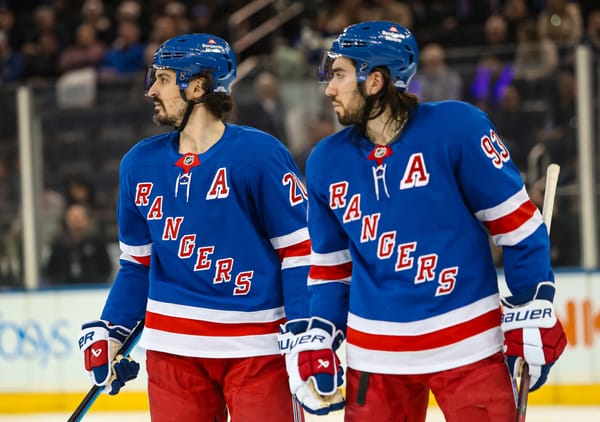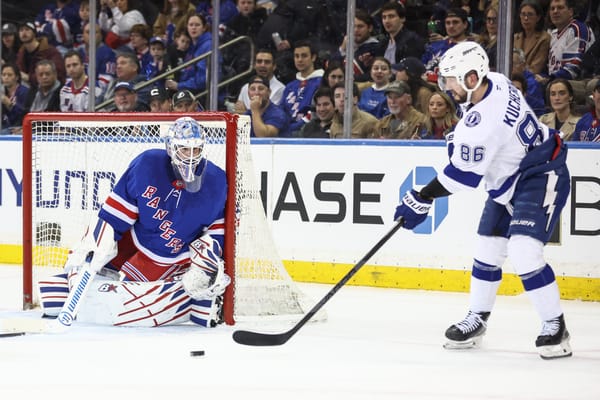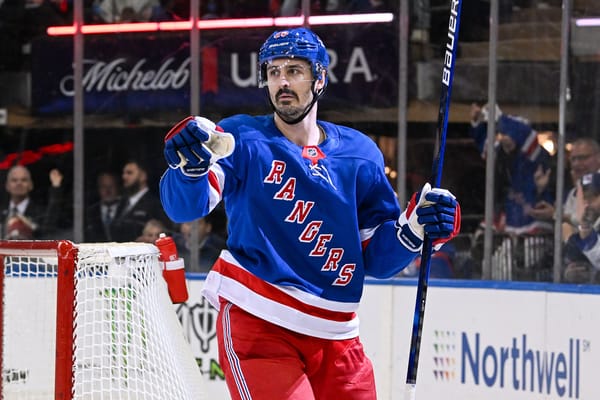2019 Report Card: Kevin Shattenkirk
A look at Shattenkirk’s second year in New York
Expectations
Kevin Shattenkirk’s first year in New York did not go the way that he planned.
He played only 46 games last year and was shut down in January due to a torn meniscus. It was the first time since the lockout-shortened 2012-13 season that Shattenkirk didn’t finish the regular season with at least 40 points. However, he did manage to pick up an impressive 23 points despite playing through the injury since late September.
The Rangers signed Shattenkirk to be the elite power play quarterback he proved himself to be in St. Louis with the Blues and in Washington with the Capitals. While it didn’t happen in his first year, he came into the 2018-19 season healthy and ready to assume that role. Back in the fall, it was also clear that he was going to be asked to do some heavy lifting at even strength because of the uncertainty surrounding Neal Pionk and Tony DeAngelo. The addition of Adam McQuaid gave the Rangers more depth on the right side, but that did little to take the heat off of Shattenkirk. All eyes were on him.
Shattenkirk entered his second season with the Rangers healthy and eager for a fresh start. He also came into the season with a preexisting relationship with David Quinn, the Rangers’ new head coach. At the start of the year, it looked like that familiarity could set the stage for Shattenkirk to rebound and return to form.
Performance
It didn’t take long for head coach David Quinn to make it perfectly clear that Shattenkirk would not receive preferential treatment. He scratched the veteran defenseman just four games into the season. We were expecting some signs of rust from Shattenkirk after he was shut down last January, but that early trip to the doghouse was very much a surprise.
It's possible off of reports from Rangers practice today that Kevin Shattenkirk will be scratched against San Jose on Thursday. That's telling of Shattenkirk's play so far and a big move by David Quinn, who is clearly demonstrating this is his team and wielding the power he has.
— Dan Rosen (@drosennhl) October 9, 2018
Despite that rocky start, and a second scratching in early March, one can definitely build a strong case that Shattenkirk was the Rangers’ best defenseman at even strength this season.
When Shattenkirk was on the ice at even strength, the Rangers actually had a fighting chance of drawing even in the shot share, which is something they struggled to do as a team all year long. His 50.39 expected goals for percentage (xGF%) at 5v5 was the best on the blue line, as was his 4.22 relative Corsi For percentage (Rel CF%). Those numbers are noteworthy on their own, even on a bad defense, but look significantly better when you consider the fact that Shattenkirk had a 98.56 PDO. The only regular on the blue line who had a worst PDO was Neal Pionk.
There were 108 defensemen in the NHL who clocked at least 1,100 minutes of 5v5 ice time this season. Shattenkirk finished with the 89th-lowest PDO among that group. More importantly, he also had the ninth-highest Rel CF% among that group. Of course, you can’t boil down the overall performance of defenseman by their possession numbers, but Shattenkirk’s underlying numbers at 5v5 definitely stood out on the Blueshirts’ blue line this year.
At even strength, Shattenkirk’s scoring rate was second only to Tony DeAngelo among New York’s defensemen. His 0.43 primary assists per 60 minutes (P1/60) led the Rangers’ defense and was tied with P.K. Subban for the 23rd best rate of first assists among NHL defensemen who played at least 1100 minutes of 5v5 hockey.
Even with his 0.93 shooting percentage at 5v5 this year, Shattenkirk finished with the second-best 5v5 point total of his career (17 points). He also notched eight primary assists at 5v5 for just the third time in his career. Clearly, he made an impact at even strength on a team that finished 26th in the league in 5v5 goals at the end of the regular season.
When we talk about Shattenkirk’s production, we also have to turn the spotlight on what he did — or didn’t do — on the power play. After all, 146 of the 298 career points — or 48.99 percent — he scored before he became a Ranger were picked up on the man-advantage.
This season Shattenkirk had just seven power play points; the same total he had in the 19 regular season games he played with the Capitals at the tail end of the 2016-17 season. Yeah, that’s pretty bad. So, what happened?
Under Quinn and his coaching staff, Shattenkirk was demoted from the top pair in favor of younger puck-moving defenseman — Neal Pionk and Anthony DeAngelo — for stretches of the regular season. There was clearly a change in his role with the team. Last year, he led all Rangers skaters with an average of 3:11 TOI/GP on the power play. This year, he finished fifth among Rangers skaters with 2:26 PP TOI/GP on the man advantage and dropped to sixth after the trade deadline when DeAngelo began his reign as the top unit’s quarterback.
However, Shattenkirk still led all Rangers’ blueliners in total ice time on the power play. So, there’s more to his meek production than just unlucky shooting and Quinn depriving him of opportunities on the man-advantage. The bottom line is that he didn’t do enough with the time that he had on the power play, especially when compared head-to-head with DeAngelo.
When Quinn scratched Shattenkirk in early March, it was clear that the defenseman’s lackluster performance on the power play was a contributing factor behind that decision. It’s hard to look past the fact that Shattenkirk had one power play point — an assist — in his last 23 games of the season.
“He’s got to break some old habits. Speed it up,” Quinn said. “We showed him some of his St. Louis power play stuff and how different he looks on the power play there than here. The pace of his play was quicker.”
It’s also important to note that Shattenkirk’s season was derailed by a separated shoulder he suffered in December. That injury held him out of the lineup for three weeks and came during his longest scoring drought of the season. Shattenkirk put up 20 points in 44 games after returning from that injury; he had eight points in his first 29 games of the season.
Grade: C+ | Banter Consensus: C+
Shattenkirk matched and perhaps even slightly exceeded expectations in regards to his play at even strength, but was a disappointment on the man advantage. He was inconsistent with the puck on his stick; that inconsistency led to him being a healthy scratch in two games and to him losing his role on the top power play unit.
It’s not fair to hold his injury in mid-December against him, nor is it fair to judge him too harshly by his slow start after the serious injury he suffered last season. However, it’s not unreasonable to expect more from Shattenkirk given his experience, his skill set, and his history of making an impact on the power play.
With any luck, the third season will be the charm for the New York native.
All data courtesy of Corsica.hockey and naturalstattrick.com. All salary information courtesy of CapFriendly.com.
2019 Report Cards: Ryan Strome / Filip Chytil / Brendan Lemieux / Tony DeAngelo / Chris Kreider / Pavel Buchnevich | Neal Pionk | Boo Nieves




